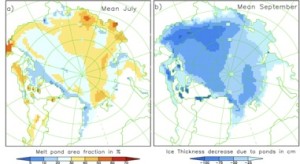Daniela Flocco, David Schroeder, Daniel Feltham
We have implemented into the CICE sea ice climate model component an explicit model of melt ponds, developed in Flocco et al [2010] and earlier papers. The CICE model has been run in stand-alone mode with imposed atmospheric and oceanic forcing and the impact of melt ponds on the sea ice state, including sea ice extent and thickness, assessed.
In our simulations, melt ponds form in the beginning of June, reach a maximum extent in July and refreeze during August. The area of sea ice, which is covered by ponds, varies from 10% to 60% with maximum values along the ice edge and minimum values over the thicker ice north of Canada (see Figure 1a). These results are reasonable with respect to observations. To investigate the impact of the pond scheme on simulating sea ice properties we performed a CICE run without ponds. The mean September ice extent is 15% lower in simulations with ponds and the September ice up to 1 m thinner (see Figure 1b). A Comparison with SSM/I observations demonstrates that CICE with our melt pond scheme is able to simulate the Arctic sea ice variability during the period 1990 to 2007 realistically. The incorporation of a melt pond routine in a sea ice model is necessary and crucial for future sea ice forecasts.
Figure 1: (a) Melt pond area (fraction of sea ice area) for climatological July (mean over the period 1990 to 2007) in our CICE simulation, (b) Ice Thickness difference for climatological September between CICE simulation with and without melt ponds.
References:
Flocco, D, DL Feltham, AK Turner, 2010. Incorporation of a physically-based melt pond scheme into the sea ice component of a climate model. J. Geophysical Research, doi:10.1029/2009JC005568.
Flocco, D and DL Feltham, A continuum model of melt pond evolution on Arctic sea ice, J. Geophysical Research, 112, C08016, doi:10.1029/2006JC003836, 14 pages, 2007.

